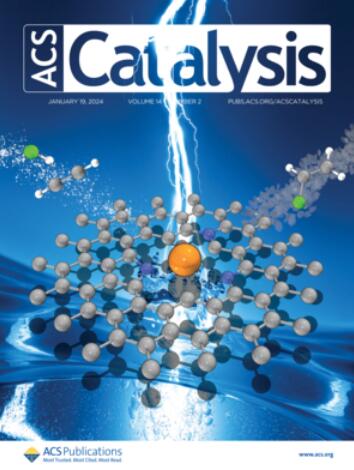Discovering Ni/Cu Single-Atom Alloy as a Highly Active and Selective Catalyst for Direct Methane Conversion to Ethylene: A First-Principles Kinetic Study
IF 11.3
1区 化学
Q1 CHEMISTRY, PHYSICAL
引用次数: 0
Abstract
Direct methane conversion to liquid fuels or value-added chemicals is a promising technology to utilize natural resources without resorting to further petroleum extraction. However, discovering efficient catalysts for this reaction is challenging due to either coke formation or unfavorable C–H bond activation. Herein, we design single-atom alloy (SAA) catalysts to simultaneously eliminate the above two bottlenecks based on mechanism-guided strategies: (1) the active single atom enables favorable C–H bond breaking and (2) the less reactive host metal facilitates C–C coupling and thus avoids strong binding of carbonaceous species. Employing electronic structure theory calculations, we screened the stability of multiple SAAs with 3d-5d transition metals atomically dispersed on a copper surface in terms of avoiding dopant aggregation and segregation. We then evaluated reactivities of the stable SAAs as catalysts for direct methane conversion to C2 products, including methane dehydrogenation and C–C coupling mechanisms. Combining selectivity analysis with kinetic modeling, we predicted that nickel dispersed on copper, i.e., Ni/Cu SAA, is a highly active and selective catalyst that can efficiently transform methane to ethylene. This work designs efficient SAA catalysts for direct methane activation and provides chemical insights into engineering compositions of SAAs to tune their catalytic performances.

发现Ni/Cu单原子合金作为甲烷直接转化为乙烯的高活性和选择性催化剂:第一性原理动力学研究
直接将甲烷转化为液体燃料或增值化学品是一种很有前途的技术,可以利用自然资源,而无需进一步开采石油。然而,由于焦炭的形成或不利的C-H键激活,发现有效的催化剂是具有挑战性的。为此,我们设计了单原子合金(SAA)催化剂,以同时消除上述两个瓶颈,基于机制导向策略:(1)活性单原子有利于C-H键断裂;(2)活性较低的宿主金属有利于C-C偶联,从而避免了碳质物种的强结合。利用电子结构理论计算,我们从避免掺杂剂聚集和偏析的角度,筛选了3d-5d过渡金属原子分散在铜表面的多种SAAs的稳定性。然后,我们评估了稳定的SAAs作为甲烷直接转化为C2产物的催化剂的反应活性,包括甲烷脱氢和C-C偶联机制。结合选择性分析和动力学建模,我们预测镍分散在铜上,即Ni/Cu SAA,是一种高活性和选择性的催化剂,可以有效地将甲烷转化为乙烯。本研究设计了用于甲烷直接活化的高效SAA催化剂,并为SAAs的工程组成提供了化学见解,以调整其催化性能。
本文章由计算机程序翻译,如有差异,请以英文原文为准。
求助全文
约1分钟内获得全文
求助全文
来源期刊

ACS Catalysis
CHEMISTRY, PHYSICAL-
CiteScore
20.80
自引率
6.20%
发文量
1253
审稿时长
1.5 months
期刊介绍:
ACS Catalysis is an esteemed journal that publishes original research in the fields of heterogeneous catalysis, molecular catalysis, and biocatalysis. It offers broad coverage across diverse areas such as life sciences, organometallics and synthesis, photochemistry and electrochemistry, drug discovery and synthesis, materials science, environmental protection, polymer discovery and synthesis, and energy and fuels.
The scope of the journal is to showcase innovative work in various aspects of catalysis. This includes new reactions and novel synthetic approaches utilizing known catalysts, the discovery or modification of new catalysts, elucidation of catalytic mechanisms through cutting-edge investigations, practical enhancements of existing processes, as well as conceptual advances in the field. Contributions to ACS Catalysis can encompass both experimental and theoretical research focused on catalytic molecules, macromolecules, and materials that exhibit catalytic turnover.
 求助内容:
求助内容: 应助结果提醒方式:
应助结果提醒方式:


